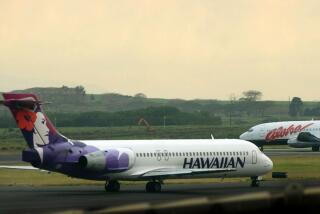2 ‘Puddle-Jumpers’ Make It to the Altar : Piedmont Airlines’ Logo to Disappear as It Finally Joins USAir
- Share via
WINSTON-SALEM, N.C. — After a long engagement between two original puddle-jumpers, one of the biggest airline marriages will take place this Saturday, when Piedmont Airlines assumes the name of suitor USAir Group Inc.
The union will create an airline that employs more than 48,000 people operating a fleet of 426 jets in 36 states, two Canadian provinces, the Bahamas and Britain.
Figures compiled by the Air Transport Assn. in Washington show the combined operations would rank USAir as the seventh largest in terms of capacity. The two airlines flew more than 59 million passengers last year.
The courtship between USAir and Piedmont was brief and expensive, and came at a time the airline market was becoming carnivorous. USAir bought Piedmont for $1.59 billion cash.
“Piedmont folks expected people would have to spend a heck of a lot of money,” said Dan Brock, vice president of marketing services for USAir and former senior vice president of marketing for Piedmont.
“There was a strong feeling of self worth,” he said. “We knew we were good, and we wanted to be good. I don’t think it surprised anybody that we went for such a big price.”
The USAir-Piedmont merger reflected a broad move throughout the deregulated airline industry to gain strength through size. Delta Airlines bought Western Airlines, Texas Air acquired People Express and Eastern, Northwest Airlines bought Republic Airlines and Trans World Airlines bought Ozark Airlines.
TWA had also wanted to buy USAir, making the Piedmont purchase more important to USAir’s struggle to retain its identity.
Piedmont employees are expected to miss their own identity, established by the company 41 years ago when it began flying out of Winston-Salem with small, noisy prop planes. But Brock said Piedmont isn’t moving into hostile territory.
Birds of a Feather
“It is a marriage to a partner who is so similar to us,” Brock said. “We have had to struggle. So have they. We began with a role of flying from small cities to big cities, and USAir was much the same. We were lucky to be acquired by someone so much like us.”
“Employees felt a sense of loss, from the sense that (Piedmont) was more than just a company,” he said. “The company was, and in a sense still is, a family.”
The employees have had 2 1/2 years to adjust to the idea of merging with USAir, which is headquartered near Washington.
“(Company officials) didn’t want to rush into the merger,” Brock said. “They wanted to plan it out, get the issues behind us, and know where we were going.”
At a hangar at the Smith-Reynolds Airport in Winston-Salem, workers who wore Piedmont patches toiled in the weeks before the merger to remove the Piedmont name from jets and replace it with the red and blue USAir logo.
By Saturday, Piedmont’s logo will be history.
In 1978, when deregulation of the airline industry began, the logo represented one of only a few airlines serving the small Southeastern towns that other carriers decided to skip. Piedmont’s main competition was USAir.
Rather than leave these small towns, both airlines chose to branch out and fly elsewhere as well, as deregulation allowed them to do.
“Our job had been to feed these people to other airlines in major cities,” Brock said. “With deregulation, we could start trying to feed ourselves.”
Merger talks began as early as 1986, when Piedmont Chairman William Howard held the first of several discussions with USAir Chairman Edward Colodny. Later, the bids began coming. Norfolk-Southern Corp., in February, 1987, offered $1.49 billion, or $65 a share, for Piedmont. The Norfolk, Va.-based transportation company already owned 19.5% of Piedmont’s stock.
USAir offered $71 a share, with half the 23 million outstanding common shares to be purchased in cash and the rest exchanged for USAir stock.
Piedmont wanted cash, USAir wanted Piedmont, so USAir came back with an all-cash agreement of $69 a share. Piedmont accepted the deal in March, 1987. The U.S. Transportation Department approved it half a year later, and the planning for a smooth merger has been under way since.
More to Read
Inside the business of entertainment
The Wide Shot brings you news, analysis and insights on everything from streaming wars to production — and what it all means for the future.
You may occasionally receive promotional content from the Los Angeles Times.










